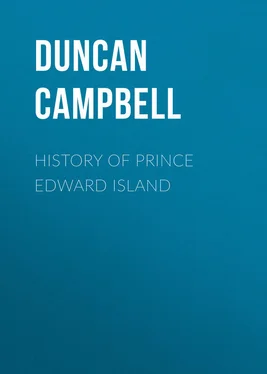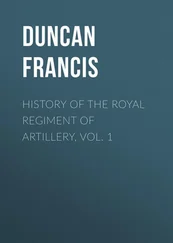Duncan Campbell - History of Prince Edward Island
Здесь есть возможность читать онлайн «Duncan Campbell - History of Prince Edward Island» — ознакомительный отрывок электронной книги совершенно бесплатно, а после прочтения отрывка купить полную версию. В некоторых случаях можно слушать аудио, скачать через торрент в формате fb2 и присутствует краткое содержание. ISBN: , Жанр: foreign_antique, foreign_prose, Историческая проза, на английском языке. Описание произведения, (предисловие) а так же отзывы посетителей доступны на портале библиотеки ЛибКат.
- Название:History of Prince Edward Island
- Автор:
- Жанр:
- Год:неизвестен
- ISBN:http://www.gutenberg.org/ebooks/35835
- Рейтинг книги:3 / 5. Голосов: 1
-
Избранное:Добавить в избранное
- Отзывы:
-
Ваша оценка:
- 60
- 1
- 2
- 3
- 4
- 5
History of Prince Edward Island: краткое содержание, описание и аннотация
Предлагаем к чтению аннотацию, описание, краткое содержание или предисловие (зависит от того, что написал сам автор книги «History of Prince Edward Island»). Если вы не нашли необходимую информацию о книге — напишите в комментариях, мы постараемся отыскать её.
History of Prince Edward Island — читать онлайн ознакомительный отрывок
Ниже представлен текст книги, разбитый по страницам. Система сохранения места последней прочитанной страницы, позволяет с удобством читать онлайн бесплатно книгу «History of Prince Edward Island», без необходимости каждый раз заново искать на чём Вы остановились. Поставьте закладку, и сможете в любой момент перейти на страницу, на которой закончили чтение.
Интервал:
Закладка:
In a letter addressed to the Earl of Hillsborough, Captain Holland reports most favourably respecting the capabilities of the island. He adds, “There are about thirty Acadian families on the island, who are regarded as prisoners, and kept on the same footing as those at Halifax. They are extremely poor, and maintain themselves by their industry in gardening, fishing, fowling, &c. The few remaining houses in the different parts of the island are very bad, and the quantity of cattle is but very inconsiderable.” At Saint Peter’s, Captain Holland met an old acquaintance, Lieutenant Burns, of the 45th Regiment, who had removed with his family to the island, and had built a house and barn, and of whom he writes to the Board of Trade very favorably.
The energy with which Captain Holland prosecuted the survey is sufficiently proved by the fact that in October, 1765, he sent home by Mr. Robinson, one of his deputies, plans of the island, as well as of the Magdalen Islands; also, a description of the Island, from which we shall quote copiously as conveying the impressions of an acute and reliable observer.
“The soil,” says Captain Holland, “on the south side of the island is a reddish clay, though in many places it is sandy, particularly on the north coast. From the East Point to Saint Peter’s it is a greyish sand. The woods upon this coast, from the East Point as far southward as Hillsborough River, and to Bedford Bay on the west, were entirely destroyed by fire about twenty-six years ago. It was so extremely violent that all the fishing vessels at Saint Peter’s and Morell River, in Saint Peter’s Bay, were burned. In many parts round the island is a rough, steep coast, from forty to fifty feet high, in some places a hundred, composed of strata of soft red stone, which, when exposed to the air for some time, becomes harder, and is not unfit for building. Wherever this sort of coast is, it diminishes considerably every year upon the breaking up of the frost, which moulders away a great part of it. It may probably be owing to this cause that the sea betwixt the island and the Continent is frequently of a red hue, and for that reason by many people called the red sea. The rivers are properly sea creeks, the tide flowing up to the heads, where, generally, streams of fresh water empty themselves. In most parts of the island the Sarsaparilla Root is in great abundance, and very good. The Mountain Shrub and Maiden Hair are also pretty common, of whose leaves and berries the Acadian settlers frequently make a kind of tea. The ground is in general covered with strawberries and cranberries, in their different seasons, which are very good. In those places which have been settled, and are still tolerably cleared, is very good grass, but a great part of the land formerly cleared is so much overgrown with brush and small wood that it would be extremely difficult to make it fit for the plough. It may be proper to observe that very few houses mentioned in the explanation of the Townships are good for anything, and by no means tenantable, except one or two at Saint Peter’s, kept in repair by the officers, and one kept by myself at Observation Cove.”
After describing the kinds of Timber to be found on the island, Captain Holland proceeds to say: “Port la Joie (Charlottetown), Cardigan and Richmond Bays are without dispute the only places where ships of burthen can safely enter, and consequently most proper to erect the principal towns and settlements upon. In point of fishing, Richmond Bay has much the advantage of situation, the fish being in great plenty most part of the year, and close to the harbour.
“The capital, to be called Charlottetown, is proposed to be built on a point of the harbour of Port la Joie, betwixt York and Hillsborough Rivers, as being one of the best and central parts of the island, and having the advantage of an immediate and easy communication with the interior parts by means of the three fine rivers of Hillsborough, York, and Elliot. The ground designed for the town and fortifications is well situated upon a regular ascent from the waterside. A fine rivulet will run through the town. A battery or two some distance advanced will entirely command the harbour, so that an enemy attempting to attack the town cannot do so without great difficulty. Having passed the battery at the entrance to the harbour, he must attempt a passage up Hillsborough and York Rivers, the channels of both which are intricate; and the entrance of the respective channels will be so near the town that a passage must be attended with the greatest hazard. Should an enemy land troops on either side the bay of Hillsborough, they must still have the river of the same name on the east, or Elliot or York rivers on the west to pass before they can effect anything of consequence.
“As this side of the Island cannot have a fishery, it may probably be thought expedient to indulge it with some particular privileges; and as all the judicial and civil, as well as a good part of the commercial business will be transacted here, it will make it at least equally flourishing with the other county towns.
“Georgetown is recommended to be built on the point of land called Cardigan Point, there being a good harbour for ships of any burthen on each side of Cardigan river on the north, or on Montague river on the south side; but the latter – though a much narrower channel in coming in – is preferable, as the bay for anchoring will be close by the town immediately on entering the river, and going round the Goose Neck – a long point of dry sand running half over the river and forming one side of Albion Bay – the place of anchorage. On the Goose Neck may be a pier, where goods may be shipped with great facility and convenience. The place proposed is so situated as to be easily made secure, as well as the entrance into the two respective harbours. There is a communication inland by means of Cardigan, Brudenell, and Montague rivers, from the top of which last to the source of Orwell river, is not quite ten miles; and Orwell river, emptying itself into the great bay of Hillsborough, makes a safe and short communication, both in winter and summer, betwixt two of the county towns.
Читать дальшеИнтервал:
Закладка:
Похожие книги на «History of Prince Edward Island»
Представляем Вашему вниманию похожие книги на «History of Prince Edward Island» списком для выбора. Мы отобрали схожую по названию и смыслу литературу в надежде предоставить читателям больше вариантов отыскать новые, интересные, ещё непрочитанные произведения.
Обсуждение, отзывы о книге «History of Prince Edward Island» и просто собственные мнения читателей. Оставьте ваши комментарии, напишите, что Вы думаете о произведении, его смысле или главных героях. Укажите что конкретно понравилось, а что нет, и почему Вы так считаете.












